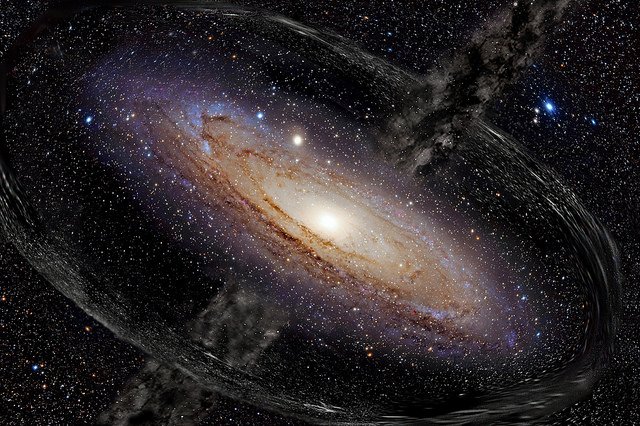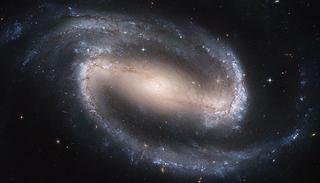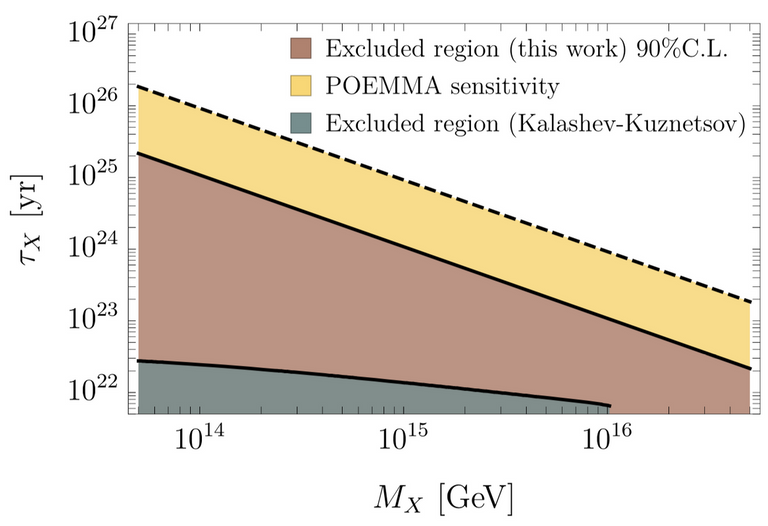I discuss today a specific class of models of particle physics featuring WIMPzillas, a potential explanation to the problematics of dark matter.

[image credits: @pab.ink]
WIMPzillas are super-heavy particles that could feature dark matter. The cool name is related to their huge mass. Typically, one single WIMPzilla would be a particle weighting as much as 1.000.000.000.000.000 hydrogen atoms.
Their huge mass makes WIMPzillas very hard to detect with standard dark matter search methods. One option is to rely on their decay into ultra-highly energetic cosmic rays.
This is what the authors of this scientific article have investigated. They determine the constraints that can be imposed on the WIMPzilla dark matter hypothesis from the searches for super-energetic cosmic rays on Earth.
Dark matter and WIMPs
As I already discussed it in many articles on my blog, dark matter is favored by many observations.

[image credits: Maxwell Hamilton (CC BY 2.0)]
Without entering into details, dark matter is indirectly evidenced, for instance, by the velocity of the stars in the galaxies, the properties of the fossil radiation remnant of the early universe or the formation of the galaxies.
However, we have no idea about the true nature of dark matter. It has to interact gravitationally. But for the rest, who knows?
Consequently, there is a lot of dark matter models on the market. One very popular of them involves particles called WIMPs that consist in weakly-interacting and quite massive dark particles.
All about WIMPs
In the early universe and at very high temperature, the WIMP paradigm considers that two reactions occur at equal rates: pairs of dark matter particles are created from the annihilation of highly-energetic Standard Model particles, and pairs of dark matter particles annihilate into Standard Model particles. The amount of created and annihilated dark matter is hence equal.
The universe however expands and the temperature drops. The Standard Model particles are thus less and less energetic with time and at some point, dark matter cannot be created anymore. Later on, dark matter becomes too diluted in the expanding universe to continue annihilating. Its density is said to freeze out.

[image credits: NASA / ESA]
The amount of dark matter present in the universe today is well measured. We can thus see under which conditions the WIMP paradigm works.
First, one needs a dark matter particle with a mass close to the mass of the weak bosons, i.e., the particles responsible for the mediation of the weak interactions.
Second, the production and annihilation rates related to the above-mentioned processes must be similar to those of typical processes mediated by the weak interactions.
This is the so-called WIMP-miracle and the explanation for the WI part of the acronym (Weakly-Interacting). In addition, WIMPs naturally arise in many extensions of the Standard Model.
For these reasons, most experimental search efforts to detect dark matter have been focused on WIMPs. Despite these efforts, no WIMP has however been found so far. It is therefore important to explore alternatives.
WIMPzillas and Auger
One potential alternative to WIMP consists in assuming that dark matter is made of super-weakly interacting supermassive particles traditionally coined WIMPzillas. In this case, we must forget about the equilibrium above-mentioned as dark matter is too weakly interacting. Only gravity matters, as could be motivated by the fluctuations in the cosmic microwave background (the fossil radiation left over from the epoch of the formation of the first atoms, in the universe history).
The WIMPzillas supermassive and super-weakly-interacting properties allow them to escape all searches. However, their properties imply that they (rarely) decay into ultra-highly energetic particles. The ultra-high-energy is connected to the large WIMPzilla mass (Einstein told us that mass is energy). Once produced, the decay products of the WIMPzillas are traveling into space under the form of ultra-highly energetic cosmic rays.

[image credits: Roberto Fiadone (public domain)]
This gives us hope to detect them, in particular with the Pierre Auger observatory based in Argentina and aiming to study ultra-highly energetic cosmic rays.
This observatory is a huge 3000 km2 array of detectors recording the interactions of any ultra-highly energetic cosmic ray with the atmosphere.
When a ultra-highly energetic cosmic ray enters the atmosphere, it quickly hits a particle of air, which gives rise to less energetic (but still very very energetic) secondary particles. The latter themselves interact later with the atmosphere, which gives more particles. And so on…
We hence end up with a spatially-spread shower of particles. The spread of this air shower implies that we need a huge detector to observe it. This is exactly what is Auger.
Take-home message: cornering WIMPzillas with cosmics
WIMPzillas are super-weakly-interacting super-massive particles and consist in an interesting idea to explain dark matter. Their main signatures rely on their potential decay into ultra-highly energetic cosmic rays. The latter can be detected with experiments like Auger, or with the future POEMMA satellite experiment scrutinizing the atmosphere for the above-mentioned air showers.
Taking the observations of Auger and the prospects of POEMMA, the authors of this scientific article have constrained the WIMPzilla paradigm as shown below.

[image credits: arXiv:1903.05429]
The x-axis corresponds to the WIMPzilla mass (given in GeV, 1 GeV being the mass of one proton). Those guys are indeed very heavy. On the y-axis, we have the lifetime of those particles. It must be large enough for preventing all dark matter to have decayed today. However, some dark matter is allowed to decay, so that we have a handle on the model.
The results of Auger (in brown) put a lower bound on the lifetime as a function of the WIMPzilla mass. In yellow, we can see the POEMMA prospects. The WIMPzilla hypothesis is thus more and more constrained, especially if it is lightish. The future will also allow to increase the senstivity to the model. This is crucial as detecting dark matter requires to cover all options as much as possible.
SteemSTEM
SteemSTEM aims to make Steem a better place for Science, Technology, Engineering and Mathematics (STEM) and to build a science communication platform on Steem.
Make sure to follow SteemSTEM on steemstem.io, Steemit, Facebook, Twitter and Instagram to always be up-to-date on our latest news and ideas. Please also consider to support the project by supporting our witnessdelegating to @steemstem for a ROI of 65% of our curation rewards (quick delegation links: 50SP | 100SP | 500SP | 1000SP | 5000SP | 10000SP). (@stem.witness) or by
Wow 1.000.000.000.000.000 hydrogen atoms!
Dark Matter is completely freaky.
How is a particle like this formed? Did you mentioned it?
Best
Posted using Partiko Android
What do you mean exactly by formed? If what you refer to is what was going on in the early universe, there are several mechanisms that could give rise to WIMPZilla production.
For instance, the transition between the inflation phase and matter-dominated phase in the universe history could generate their gravitational production. Technical details can be found here.
Another option would be WIMPZilla production during the reheating phase of the universe history. After inflation, the universe warns up and a fraction of the available energy could be use to produce WIMPzillas. See here.
Does it answer your question?
Hey Lemouth, this definitely answers my question!
Your post has been made a few days ago but I can remember you mentioned that these particles are hard to detect. My question would be: Why? Is it not easier to detect an elephant instead of a mosquito?
And here it's godzilla ;-)
Cheers
Chapper
Dark matter direct detection rely on the interactions of dark matter with normal matter. Here, we have an elephant but very feebly interacting. Therefore, we can't see it because it just does not interact at all with the detector.
I have to wonder, is WIMPzilla really the scientific name? And is WIMP an acronym?
Also, great article, as always! Reading your posts I've discovered that particle physics, while complicated, is a lot more interesting than I thought
Posted using Partiko Android
WIMPzilla is really the scientific name that has been used in numerous publications. I think the first mention of it is from Kolb and company, in this article that attracted more than 100 citations in 20 years.
WIMP stands for Weakly-Interacting Massive Particle. I should have mentioned it more clearly in the blog post. Thanks for bringing it in.
Reading this makes me very happy! Thanks a lot!
Correct me if I'm wrong, but wouldn't 1.000.000.000.000.000 hydrogen atoms weigh ~1.6 nanograms? I can't even detect regular matter that small.
Also, awesome to hear that Argentina has a world-reknown observatory.
Yes this is correct. We are dealing with macroscopic weights (1 ng is roughly speaking the weight of a single human cell) attached to elementary particles. So it is really huge!
A unique observatory that has been built to be the best in the world for this kind of physics.
What are your thoughts on the April 10th announcement? Are we going to see the first photo of the event horizon of the black hole in the center of our galaxy?
In this case, I am like anyone else as I have no collaborator in the EHT collaboration. Therefore, we need to wait until tomorrow. One thing that seems to emerge from rumours (note that rumours are bad by essence) is that the announcement concerns the first image of a black hole ever. Clearly exciting! ;)
Sorry, I'm not a scientist, I've only seen lots of movies. I tought that this quotes by the movie "Godzilla - Size does matter" could be useful
You may want to check the abstract of this article that is the first one using WIMPzilla in the title :)
I can't believe you guys actually named them WIMPzillas! Physicists are so cool!
This is a real name. There is a few articles using the word today :)
Hi @lemouth!
Your post was upvoted by Utopian.io in cooperation with @steemstem - supporting knowledge, innovation and technological advancement on the Steem Blockchain.
Contribute to Open Source with utopian.io
Learn how to contribute on our website and join the new open source economy.
Want to chat? Join the Utopian Community on Discord https://discord.gg/h52nFrV
Correct me if I'm wrong, but wouldn't 1.000.000.000.000.000 hydrogen atoms weigh ~1.6 nanograms? I can't even detect regular matter that small.
Also, awesome to hear that Argentina has a world-reknown observatory.
You said it twice? :D
Whoops, Sometimes this happens when I comment through steemstem and I can't figure out why.
Your post was mentioned in the Steem Hit Parade in the following category:Congratulations @lemouth!
Congratulations @lemouth! You have completed the following achievement on the Steem blockchain and have been rewarded with new badge(s) :
You can view your badges on your Steem Board and compare to others on the Steem Ranking
If you no longer want to receive notifications, reply to this comment with the word
STOPDo not miss the last post from @steemitboard:
Vote for @Steemitboard as a witness to get one more award and increased upvotes!
excuse me, and i know it's rude of me to just barge in after so much time but - since you identified yourself as a physics prof i dont really know where to ask this at six in the morning. I was just listening to an old bit by someone on gravitons and string theory (not claiming to understand but trying and i think scientific ebooks or casts make for great soothing background noise) - i do weird things all the time after all.
Turns out gravitons as i google it , like 95% of reality according to what i read here some time before ;-) , are not proven to exist due to some mathematical problem but it says its masless and therefor travels at the speed of light (in theory) and it just got in my head "negative mass"
Is there anything you know of that writes about negative mass or has anyone taken it into account (mathematically speaking) in a way that i might be able to read or understand lol.
I mean what does that do to einsteins most famous and what does that do to the whole universe if 95% is already missing ? That would mean even more because the negative mass would have to be subtracted from the numbers but the particles would be there ? or not ?
just wondering, right, totally okay if you dont answer, its been a while after all .. i hope you dont get beeps on your phone from steemit at 6am
and i hope you're ok ...
and i'm sure you're very busy, have a great day !!
Graviton are hypothetical since they have not been observed yet. Actually, their properties are such that we cannot observe them with the experimental setups of today. However, theoretically, in the framework of quantized gravity (which is also an open problem), they are well-defined.
So in short, you are right with the graviton.
On the other hand, there is no such a thing as a negative mass. One could get 'effective masses' that would act as 'negative masses' in some context, but the word 'effective' is important.
For the rest of the question, I didn't get it :D
why does everyone keep telling me that , lol, even physics professors "i dont get what you're saying"

i always felt like i was born on proxima centauri and fell through a hole in space to a place that's alien to me but it seems to get worse lately :p
i meant actually purely hypothetical and mathematical, just for the sake of the thought what would it do the formulas like when you introduce infinity to einsteins pretty one i personally read that "all you need to propel at the speed of light - or faster - is infinite energy"
which has had me nailed to the cross and burned to the stake but im used to that since the dark ages , cats and witches and all that, purely as a mathematical concept
if you introduce the minus sign to mass
its nothing important, just one of my
thoughts :)
thanks for replying despite my total lack of presence and late to the post !!!!
For the fun fact: So far there is no way to get faster than the speed of light. But if you just want to get to the speed of light, you indeed need some infinite amount of energy. If you want to be more reasonable and get very very very... very close to the speed of light, you only need so much gas that there is no way to build a ship large enough :D